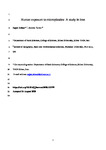Human exposure to microplastics: A study in Iran
| dc.contributor.author | Abbasi, S | |
| dc.contributor.author | Turner, Andrew | |
| dc.date.accessioned | 2020-10-05T11:47:11Z | |
| dc.date.available | 2020-10-05T11:47:11Z | |
| dc.date.issued | 2021-02-05 | |
| dc.identifier.issn | 0304-3894 | |
| dc.identifier.issn | 1873-3336 | |
| dc.identifier.other | 123799 | |
| dc.identifier.uri | http://hdl.handle.net/10026.1/16474 | |
| dc.description.abstract |
Exposure of microplastics (MPs) to a cohort of adults of various demographics from different regions of Iran has been quantitatively assessed. Specifically, MPs were retrieved from filtered washes of the hand and face skin, head hair and saliva of individuals (n = 2000) after an exposure period of 24 h and were counted and, in a selected number of cases, characterised for shape-form and size microscopically. A total of over 16,000 MPs were recorded in the study, with head hair returning the most samples (> 7000, or, on average, >3.5 MPs per individual per day), saliva returning the least samples (about 650, or on average 0.33 MPs per individual), and MPs about twice as high in males than females. The number of MPs was similar amongst residents of different urbanised regions, albeit with evidence of greater quantities captured in more humid settings, and was considerably lower in residents of a remote and sparsely populated area. Polyethylene-polyethylene terephthalate and polypropylene fibres of < 100 μm in length, likely derived from clothing and soft furnishings in the indoor setting and a wider range of sources in the exterior environment, were the most abundant type of MP in all body receptors. Daily sampling of receptors from six participants over a seven-day period revealed that, despite these broad trends, both inter- and intra-individual exposure was highly heterogeneous. Although the present study has demonstrated the ubiquity of MP exposure, the resulting impacts on human health are unknown. | |
| dc.format.extent | 123799-123799 | |
| dc.format.medium | Print-Electronic | |
| dc.language | en | |
| dc.language.iso | en | |
| dc.publisher | Elsevier BV | |
| dc.subject | Microplastics | |
| dc.subject | Human | |
| dc.subject | Exposure | |
| dc.subject | Hair | |
| dc.subject | Skin | |
| dc.subject | Saliva | |
| dc.title | Human exposure to microplastics: A study in Iran | |
| dc.type | journal-article | |
| dc.type | Journal Article | |
| plymouth.author-url | https://www.webofscience.com/api/gateway?GWVersion=2&SrcApp=PARTNER_APP&SrcAuth=LinksAMR&KeyUT=WOS:000595861600002&DestLinkType=FullRecord&DestApp=ALL_WOS&UsrCustomerID=11bb513d99f797142bcfeffcc58ea008 | |
| plymouth.volume | 403 | |
| plymouth.publication-status | Published | |
| plymouth.journal | Journal of Hazardous Materials | |
| dc.identifier.doi | 10.1016/j.jhazmat.2020.123799 | |
| plymouth.organisational-group | /Plymouth | |
| plymouth.organisational-group | /Plymouth/Faculty of Science and Engineering | |
| plymouth.organisational-group | /Plymouth/Faculty of Science and Engineering/School of Geography, Earth and Environmental Sciences | |
| plymouth.organisational-group | /Plymouth/REF 2021 Researchers by UoA | |
| plymouth.organisational-group | /Plymouth/REF 2021 Researchers by UoA/UoA07 Earth Systems and Environmental Sciences | |
| plymouth.organisational-group | /Plymouth/Research Groups | |
| plymouth.organisational-group | /Plymouth/Research Groups/BEACh | |
| plymouth.organisational-group | /Plymouth/Research Groups/Marine Institute | |
| plymouth.organisational-group | /Plymouth/Users by role | |
| plymouth.organisational-group | /Plymouth/Users by role/Academics | |
| dc.publisher.place | Netherlands | |
| dcterms.dateAccepted | 2020-08-24 | |
| dc.rights.embargodate | 2021-9-5 | |
| dc.identifier.eissn | 1873-3336 | |
| dc.rights.embargoperiod | Not known | |
| rioxxterms.versionofrecord | 10.1016/j.jhazmat.2020.123799 | |
| rioxxterms.licenseref.uri | http://www.rioxx.net/licenses/all-rights-reserved | |
| rioxxterms.licenseref.startdate | 2021-02-05 | |
| rioxxterms.type | Journal Article/Review |


